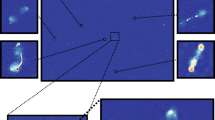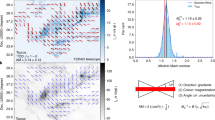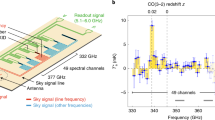Abstract
MAGNETIC flux at the surface of the Sun is predominantly concentrated in discrete areas with kilogauss field strengths1. Except for sunspots, these areas are too small to have been resolved by conventional observations. These magnetic flux tubes are an essential part of the physics of the activity and heating of the outer atmosphere of the Sun and other late-type stars2, but although their average properties have been studied in considerable detail3,4, direct observations of them have been lacking because of turbulence in the Earth's atmosphere, which limits resolution to ∼400 km. Using a newly developed technique of speckle inter-ferometry5, we have obtained simultaneous direct observations of the white-light and magnetic field signature of flux tubes. Individual flux tubes are seen, with resolved diameters of ∼200 km and continuum brightness contrast of at least +30%. Magnetic features larger than 300 km in size tend, however, to be darker than their surroundings.
This is a preview of subscription content, access via your institution
Access options
Subscribe to this journal
Receive 51 print issues and online access
$199.00 per year
only $3.90 per issue
Buy this article
- Purchase on Springer Link
- Instant access to full article PDF
Prices may be subject to local taxes which are calculated during checkout
Similar content being viewed by others
References
Stenflo, J. O. Solar Phys. 32, 41–63 (1973).
Spruit, H. C. & Roberts, B. Nature 304, 401–406 (1983).
Stenflo, J. O. Astr. Astrophys. Rev. 1, 3–48 (1989).
Solanki, S. K. in Solar Photosphere: Structure, Convection, and Magnetic Fields IAU Symp. 138 (ed. Stenflo, J. O.) 103–120 (Kluwer, Dordrecht, 1990).
Keller, C. U. & von der Lühe, O. Astr. Astrophys. 261, 321–328 (1992).
Frazier, E. N. & Stenflo, J. O. Solar Phys. 27, 330–346 (1972).
Mehltretter, J. P. Solar Phys. 38, 43–57 (1974).
Muller, R. Solar Phys. 85, 113–121 (1983).
Schüssler, M. & Solanki, S. K. Astr. Astrophys. 192, 338–342 (1988).
Muller, R., Roudier, Th. & Hulot, J. C. Solar Phys. 119, 229–243 (1989).
Keller, C. U., Solanki, S. K., Steiner, O. & Stenflo, J. O. Astr. Astrophys. 233, 583–597 (1990).
Dunn, R. B. & Zirker, J. B. Solar Phys. 33, 281–304 (1973).
Title, et al. in Physics of Magnetic Flux Ropes (eds Russell, C. T., Priest, E. R. & Lee, L. C.), 171–179 (Am. Geophys. Un., Washington DC, 1990).
Muller, R. & Keil, S. L. Solar Phys. 87, 243–250 (1983).
Schüssler, M. in Solar Photosphere: Structure. Convection, and Magnetic Fields, IAU Symp. 138 (ed. Stenflo, J. O.), 161–179 (Kluwer, Dordrecht, 1990).
Simon, G. W. & Zirker, J. B. Solar Phys. 35, 331–342 (1974).
Beckers, J. M. & Schröter, E. H. Solar Phys. 4, 142–164 (1968).
Zirin, H. & Wang, H. Astrophys. J. 385, L27–L29 (1992).
Spruit, H. C. & Zwaan, C. Solar Phys. 70, 207–228 (1981).
Knölker, M. & Schüssler, M. Astr. Astrophys. 202, 275–283 (1988).
Author information
Authors and Affiliations
Rights and permissions
About this article
Cite this article
Keller, C. Resolution of magnetic flux tubes on the Sun. Nature 359, 307–308 (1992). https://doi.org/10.1038/359307a0
Received:
Accepted:
Issue Date:
DOI: https://doi.org/10.1038/359307a0
This article is cited by
-
Observations of Unresolved Photospheric Magnetic Fields in Solar Flares Using Fe i and Cr i Lines
Solar Physics (2014)
-
Solar magnetic fields as revealed by Stokes polarimetry
The Astronomy and Astrophysics Review (2013)
-
UV1600 bright points and magnetic bipoles in solar quiet regions
Astrophysics and Space Science (2012)
-
Small-Scale Solar Magnetic Fields
Space Science Reviews (2009)
-
Solar Image Restoration By Use Of Multi-frame Blind De-convolution With Multiple Objects And Phase Diversity
Solar Physics (2005)
Comments
By submitting a comment you agree to abide by our Terms and Community Guidelines. If you find something abusive or that does not comply with our terms or guidelines please flag it as inappropriate.



